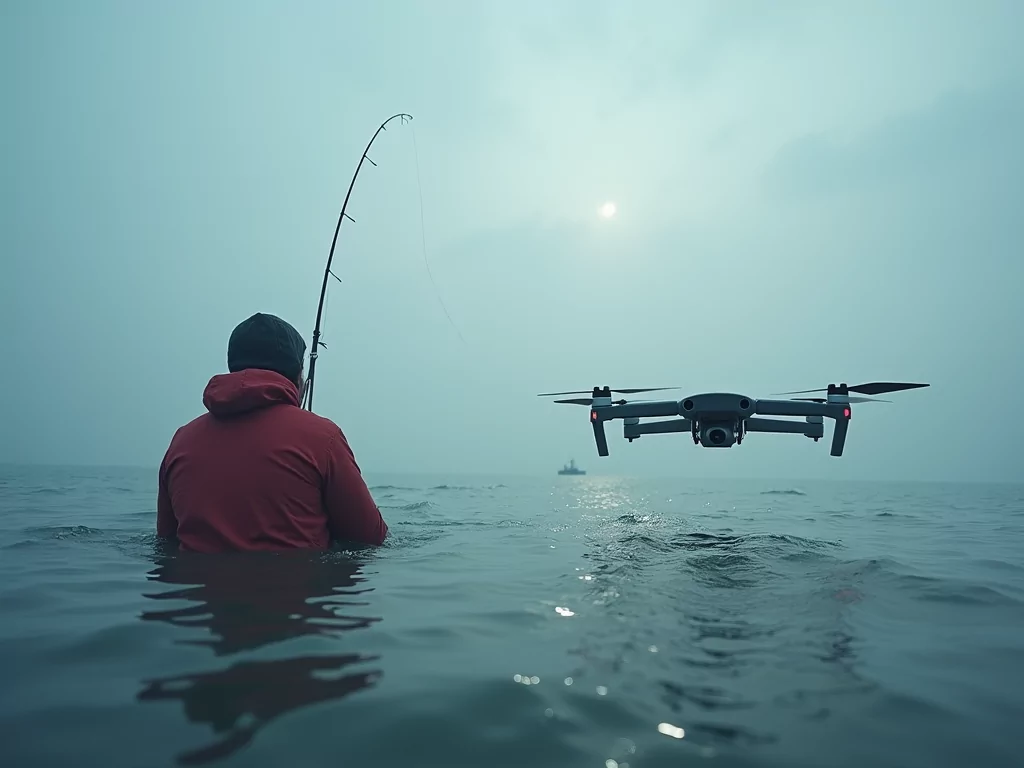Technological developments have transformed recreational fishing in recent years. From GPS-enabled trolling motors to high-tech fish finders, anglers now have equipment that simplifies locating and capturing fish compared to years ago. However, the emergence of drone fishing marks one of the most revolutionary changes in fishing technologies. Although drones provide fishermen with fascinating new opportunities, their use also raises serious ethical issues regarding fair chase and the future of the sport.
What is Drone Fishing?
Drone fishing is the application of unmanned aerial vehicles (UAVs), sometimes referred to as drones, to support various aspects of fishing operations. Anglers are using drones in numerous different ways right now:
- Reconnaissance and Scouting: High-density cameras included in many contemporary fishing drones let fishermen scan the water from above, spotting underwater structures, currents, bait schools, and even target fish species. Particularly while fishing in unfamiliar waters, this bird’s-eye view provides useful intelligence.
- Bait Delivery: Drones can carry and drop baited lines or lures far beyond the reach of traditional casting techniques. Some models even have payload release systems to allow precise rig positioning. Surf and kayak fishermen who want to reach distant fishing spots particularly favor this method.
- Fish Recovery: In some cases, anglers use drones not only to cast but also to retrieve hooked fish, essentially “ferrying” them back to their location. However, this technique is typically only feasible for smaller fish species, given consumer drones’ weight limitations.
- Underwater Exploration: The newest frontier in drone fishing is using submersible remotely operated vehicles (ROVs) to explore below the surface. Equipped with cameras, lights, and sensors, underwater drones offer a unique view of aquatic environments and can even be used to study fish behavior.
Benefits of Aerial Fishing
Advocates of drone fishing cite several advantages of the technology:
- Extended Reach: Drones allow anglers to present baits and lures well beyond the range of even the most skilled casters. This is particularly useful when targeting fish near structures or in deep water that would be difficult to access using conventional methods.
- Enhanced Accuracy: The bird’s-eye view provided by a drone’s camera allows for precise bait placement, reducing the risk of snags and increasing the chance of delivering the offering directly to the target fish.
- Efficient Scouting: By scouting with a drone, fishermen can cover more water in less time, quickly identifying prime spots for fishing. This efficiency translates to more time spent fishing and less aimless casting or trolling.
- Reduced Disruption: Drone fishing enables a more targeted approach, which could minimize disruption to non-target species and potentially lower overall fishing pressure on frequently fished waters.
Drone Fishing: Ethical Considerations
Despite the potential benefits, the use of drones in recreational fishing has sparked debate both within and outside the angling community. Critics argue that drone fishing undermines fundamental principles of sportsmanship and fair chase, crossing an ethical line.
- Ease of Fishing: One of the primary concerns is that drones eliminate the challenge and skill required to locate and catch fish independently, making fishing “too easy.” Outdoor Life fishing guide Joe Cermele compares drone fishing to “shooting a deer in a pen” and argues that the technology “takes all the sport out of fishing.”
- Animal Welfare: Animal rights advocates, including People for the Ethical Treatment of Animals (PETA), have raised concerns about the welfare of fish targeted by drones. PETA has condemned the practice, stating that “using drones to drop hooks into schools of fish and then reel them in is not only cruel but also a violation of fishing regulations in many areas.”
- Overharvesting Risks: Another ethical issue is the potential for drone fishing to contribute to overharvesting and depleting fish populations. Anglers with the ability to locate and catch large numbers of fish quickly may be tempted to target sensitive species or violate regulatory bag limits. This concern is particularly pressing in areas with limited resources for fisheries enforcement.
Laws and Regulations
As drone technology evolves rapidly, regulations governing their use in fishing have struggled to keep pace. The Federal Aviation Administration (FAA) in the United States has established general rules for recreational drone use, including a weight limit of 55 pounds, a maximum altitude of 400 feet, and a requirement to keep the drone within the operator’s visual line of sight. However, these guidelines do not specifically address fishing applications.
- State-Level Regulations: State regulations vary widely. Some states, such as Oregon and Michigan, have banned the use of drones for fishing entirely. Others, like Florida and Texas, permit drone fishing but prohibit the use of drones to locate fish or scout locations. Some states lack specific regulations, leaving the legality of drone fishing in a gray area.
- International Regulations: Countries around the world have taken different approaches to regulating drone fishing. In Australia, drone fishing is generally allowed, but operators must adhere to civil aviation laws and local fishing regulations. The Angling Trust in the United Kingdom has called for a ban on drone use to drop baits or lures, citing concerns about fair play and fish welfare.
Drone Fishing’s Future

As drone technology continues to advance and become more affordable, the use of drones in recreational fishing is likely to grow. Several manufacturers already produce fishing-specific drones with longer flight times, waterproof designs, and enhanced payload capacities. Underwater drones, though still a niche product, are also becoming more sophisticated and user-friendly.
These developments make it clear that fisheries managers and the fishing community will need to address the ethical implications of drone use and work toward establishing clear rules and guidelines. Potential solutions could include:
- Limiting Drone Use: Allow drones for scouting and reconnaissance only; prohibit their use for retrieving fish or deploying bait.
- Catch-and-Release Policies: Implement catch-and-release requirements for fish caught using drones.
- Designated Drone Fishing Areas: Set aside specific areas or times for drone fishing to minimize conflict with other anglers.
- Licensing Requirements: Require special licenses or permits for drone fishing, similar to those needed for other specialized fishing techniques like bowfishing or spearfishing.
Finding a balance between the benefits and drawbacks of drone fishing will ultimately depend on open communication, honest debate, and a shared commitment to the long-term sustainability of fisheries. By actively addressing these issues, the angling community can help ensure that fishing remains a beloved pastime for future generations, even as technology changes how we pursue and capture fish.
Frequently Asked Questions
Is drone fishing legal?
The legality of drone fishing depends on where you live. Some countries and states have explicitly banned the practice, while others allow it with certain restrictions. Always check local regulations before using a drone for fishing.
How much do fishing drones cost?
Fishing drones range from a few hundred to several thousand dollars, depending on features and capabilities. Entry-level models suitable for scouting and basic bait drops start around $500, while high-end drones with longer flight times, larger payload capacities, and waterproof designs can cost $2,000 or more.
What are the best drones for fishing?
Popular and highly rated fishing drones include the SwellPro Splash Drone 3+, PowerVision PowerRay, and DJI Phantom 4 Pro. When choosing a drone for fishing, consider factors like flight time, range, camera quality, payload capacity, and water resistance.
Can a drone help you catch big fish?
While a drone can be used to catch larger fish, most consumer drones have limited lifting capacities and are not suitable for landing very heavy fish. Drone fishing is typically most effective for small to medium-sized species.
Do you need a license to fly a fishing drone?
In the United States, flying a drone for recreational fishing does not require a special license. However, if your drone weighs more than 0.55 pounds, you must register it with the FAA and follow all applicable regulations. Some states may require additional licenses or permits for drone fishing, so be sure to check local laws.

